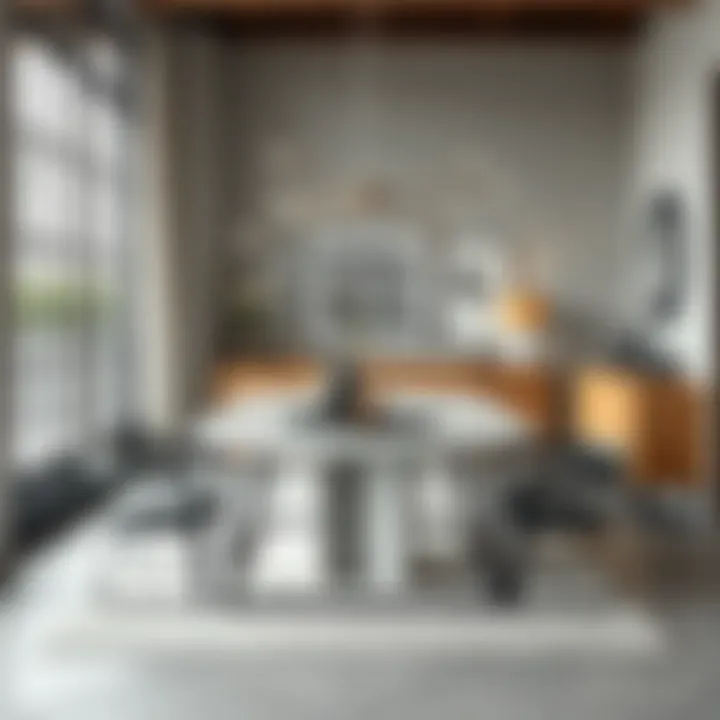Exploring the Design of Sideboards and Dining Tables


Intro
The world of furniture design is a dynamic arena where functionality meets artistry. In today's homes, key pieces like sideboards and dining tables are more than just practical elements; they serve as foundations for style, comfort, and social interaction. This exploration delves into how these two crucial items interact within the broader spectrum of contemporary design.
By weaving together the principles of form and function, we can uncover how sideboards and dining tables not only coexist but also enhance the overall aesthetic appeal of a space. Whether you're an interior designer aiming for a cohesive look or a homeowner seeking to elevate your dining experience, understanding the symbiosis between these pieces can lead to more fulfilling living spaces.
Furniture Design Trends
Trending Materials and Textures
Today’s design landscape is rich with a variety of materials that cater to diverse tastes and settings. Traditional woods such as oak and walnut remain popular, but there’s a growing trend towards sustainable options like bamboo and reclaimed wood. These materials not only offer durability but also add a unique character to each piece. Often, they’re paired with metals like steel or brass for a touch of industrial flair, resulting in a conversation starter right in your dining area.
Textures play a pivotal role too. From smooth, polished finishes to the tactile sensations of raw, unfinished surfaces, each choice can radically change the room's feel. Mixing textures is a love language of designers—think of chunky fabrics on a dining bench contrasting with a sleek, glossy tabletop. Such choices are not just about looks; they affect how people interact with the space.
Color Palettes and Styles
Color is another fascinating area of exploration in furniture design today. Neutral shades such as beige, gray, and muted greens are maintaining their status as reliable backdrops, allowing vibrant accessory pieces, like colorful sideboards or artful table settings, to take center stage. However, bolder colors are surfacing to make statements. Rich hues like deep navy or terracotta can inject personality into what might otherwise be a mundane segment of your home.
Styles are equally varied, encompassing minimalist Scandinavian vibes that focus on simplicity and function, to eclectic bohemian ensembles that embrace a mix of global influences. Designers now are leaning towards blending these styles, creating spaces that are not just aesthetically pleasing but are also deeply personal.
"The harmony in design comes from the symbiotic relationship between functionality and aesthetic appeal."
Practical Tips for Furniture Selection
Assessing Space and Functionality
Choosing the right sideboard or dining table requires careful thought on spatial design. Homeowners should consider the layout of their dining area—how much room is available for movement during mealtime? Is there sufficient space for chairs without cramping the area? Also, consider how the sideboard can enhance your dining experience. It could serve as storage for cutlery or decorative items, or perhaps as a buffet during gatherings. Prioritizing functionality doesn’t mean compromising style; it means harmonizing both to create a seamless flow in your home.
Balancing Aesthetics with Comfort
Once you have a handle on the practical aspects, the next step is finding a balance between comfort and visual appeal. An inviting dining table encourages gatherings; a well-chosen sideboard adds charm and warmth to the room. When selecting these pieces, consider your lifestyle. If you frequently host dinner parties, a spacious table with comfortable seating becomes pivotal. Likewise, a brightly colored sideboard can energize the space, inspiring creativity and conversation.
For more insights on furniture design trends, explore resources like Wikipedia on Furniture Design and Britannica's Overview of Modern Furniture.
Understanding Sideboards and Dining Tables
In the realm of home decor, sideboards and dining tables are more than just pieces of furniture; they play pivotal roles in enhancing the functionality and aesthetic appeal of our living spaces. These items are anchors in the dining area, facilitating both daily meals and special gatherings. Understanding their significance is crucial for homeowners, designers, and decorators alike, as it lays the groundwork for effective design choices.
The benefits of sideboards and dining tables are manifold. A sideboard, for instance, serves as a storage solution, keeping dining essentials organized, while also offering a surface for displaying decor or serving food. This dual function allows it to fit seamlessly into various design schemes. Dining tables, on the other hand, are central to social interactions within a home. They bring people together, making memories over shared meals.
Several considerations arise when delving into these furniture pieces. One must take into account material, size, and style—each choice can drastically alter the dynamics of a space. For example, a long wooden dining table can evoke a rustic charm, while a sleek glass table lends a contemporary feel. By carefully selecting these elements, one can create harmony within the decor.
To truly appreciate the relationship between these two pieces, we must first delve into their individual roles before examining how they can best coexist in a home setting.
Defining the Sideboard
A sideboard, often referred to as a buffet, is typically a low storage cabinet designed for the dining area. Its primary function is to provide storage for dining utensils and linens, making it a functional yet stylish addition to any room. Crafted from an array of materials—wood, metal, or glass—sideboards come in various styles that range from traditional to modern.
The beauty of a sideboard lies not only in its utility but also in its versatility. In a contemporary design, sideboards are increasingly used as a backdrop for art or photographs, creating a visual focal point in the dining space. By placing decorative items like candles, vases, or even a collection of wine bottles, we can transform mundane storage into a curated display.
Defining the Dining Table
The dining table is undeniably the heart of the home, where families gather to share meals and stories. Generally larger than a sideboard, dining tables come in various shapes, such as rectangular, round, or oval. Each shape contributes differently to the ambience and flow of a room.
When defining a dining table, the consideration goes beyond mere shape. The size is crucial, as it must accommodate the intended number of diners comfortably. A too-small table can make social gatherings feel cramped, while an oversized table may overpower smaller spaces. Furthermore, dining tables are often made from materials that include solid wood, reclaimed timber, or even engineered materials for modern looks.
The Historical Context of Furniture Design
Understanding the journey of sideboards and dining tables through time offers valuable insights into their current forms. Historically, the sideboard originated in the 18th century, primarily used to hold dishes during feasts, reflecting the social dynamics of the time.
Dining tables have also undergone significant evolution. In medieval times, large trestle tables ruled dining spaces, catering to communal eating methods before the development of individualized dining practices. Today, both sideboards and dining tables embody a rich tapestry of historical influences, modern designs, and cultural significance.
"Furniture design is not merely about utility; it is a reflection of the societal values, craftsmanship, and aesthetic trends of its time."
By comprehending their purposes rooted in history, one can appreciate how sideboards and dining tables have not only adapted to modern needs but also continue to hold cherished places in our homes.
Functional Roles in Home Decor
In the realm of home decor, the functional roles of furniture pieces extend beyond mere aesthetics. They serve as vital components, shaping our living spaces not only through their appearance but also through their utility. This section digs into how sideboards and dining tables enhance interiors while providing practical benefits that enrich the daily life of homeowners, designers, and decorators alike.
Sideboards as Storage Solutions


Sideboards are the unsung heroes of home organization. More than just a pretty facade gracing a dining room wall, they provide crucial storage capabilities. Consider the various forms these pieces take. Whether a sleek modern design or a rustic vintage find, sideboards can efficiently hide away table linens, serving dishes, and other dining necessities, keeping your space tidy.
Moreover, they offer versatility higher than most might expect. Imagine using a sideboard in a hallway or living area to hold keys, mail, or even books. It becomes a central working piece, helping to reduce clutter in multiple areas of the home. In fact, the sides of the sideboard can also play host to decorative pieces, blending functionality with style seamlessly.
A solid sideboard contributes immensely to reducing chaos, turning what could be a jumbled mess into a carefully curated display.
Dining Tables and Social Interaction
Dining tables serve as the heart of social interactions within a home. They are more than just surfaces for meals; they are rendezvous points for family gatherings, casual chats, board games, and even remote work sessions in the era of home offices. The type of dining table you choose can genuinely shape the atmosphere of the space.
When selecting a table, one should explore various styles and shapes. A round table can encourage conversation rather effectively, making it equal for all seated. On the other hand, a long rectangular table might be ideal for larger gatherings, allowing for formal dinners or banquets, and creating a more structured environment.
Practical considerations also come into play. Size, for sure, is essential. You want a table that fits comfortably without crowding the room, allowing for movement and access to other furniture pieces. Generally, larger families or those who entertain frequently might invest in extendable tables, ensuring flexibility to adapt to the number of guests.
Combination of Both for Seamless Flow
To create an inviting and functional dining space, consider how sideboards and dining tables interact. This combination fosters a seamless flow in your home, encouraging movement and communication among spaces. Adequate spacing around the dining table paired with a strategically placed sideboard allows easy access to dishes and utensils without the hassle of crossing paths with the seated diners.
A harmonious setup makes a room not just more appealing visually, but also more satisfying to live in day-to-day. Here are a few things one might keep in mind when harmonizing the two:
- Proportions: Ensure that your sideboard height aligns with the table height; having both at sightlines can make a space feel cohesive.
- Color Match: Consider how color tones of each piece complement one another. A cohesive palette can unify the room, making it feel deliberate instead of haphazard.
- Functional Flow: Evaluate pathways and ensure there's enough space for movement. Having guests walk smoothly from the table to the sideboard is essential for a laid-back atmosphere that welcomes interaction.
In summary, focusing on the functional roles of sideboards and dining tables can elevate not just the aesthetics of a home but also greatly enhance the livability. Those who take the time to integrate these elements thoughtfully will notice a marked difference in comfort and usability.
Design Principles and Aesthetics
Design principles and aesthetics play a critical role in crafting an environment that's not just functional but resonates with an individual’s style and personality. When evaluating sideboards and dining tables, attention to these aspects ensures that these pieces don’t merely occupy space but enhance the overall atmosphere of a home.
Incorporating strong design principles promotes a harmonious balance and flow throughout the room. Items like sideboards and dining tables should complement one another, becoming an integrated part of an overall decor narrative. The challenge here is to merge functionality with visual appeal, creating spaces that are both inviting and practical.
Material Selection for Durability
Wood Varieties
A major element in the construction of both sideboards and dining tables is the choice of wood. Different species offer unique characteristics suitable for varying styles and functions. For instance, oak has sturdy qualities that ensure longevity, while walnut has rich tones that provide elegance.
Choosing wood involves understanding the key characteristics of each type. Oak is often preferred for its hardness and resistance to scratches. However, its heavier weight can be a downside for those who might need to move their furniture around frequently. On the other hand, walnut brings a luxurious look, but it's typically pricier and requires more care.
Metal and Glass Options
Metal and glass are contemporary choices that can elevate a room’s aesthetic. These materials are especially popular in modern design due to their clean lines and versatility. The transparency of glass can create an illusion of space, making even smaller dining areas feel more open. Meanwhile, metals like stainless steel are favored for their durability and minimal upkeep.
However, glass can be fragile and requires careful handling, while metal might not blend well with all decors, often leading to a more industrial feel that doesn’t suit every homeowner's taste.
Style and Finish Considerations
Modern versus Traditional
The stylistic choice between modern and traditional affects not only aesthetics but also how users experience the furniture. Modern styles often embrace minimalism, focusing on sleek and uncluttered designs, while traditional styles are distinguished by intricate details and classic silhouettes.
Opting for a modern table might appeal to those wanting an airy look, yet it might lack the warmth found in traditional pieces, which can often foster a more homey and inviting atmosphere. Understanding this nuance helps in making more informed purchases that align with personal preferences.
Color Palettes and Textures
Choosing the right color and texture can breathe life into any dining area. Neutral tones are often favored for their timeless look, whereas bold colors can create wonderful focal points. Textures, too, add depth; the smoothness of lacquered finishes contrasts beautifully with matte surfaces or woven elements.
Color and texture are essential for setting the mood of the space. Too many conflicting textures may create disharmony, while a coordinated palette can make everything feel intentional and cohesive. When selecting these elements, it’s essential to envision how they will interact with lighting and other decor in the room.
"A well-chosen sideboard and dining table do more than serve functional purposes; they are central to the style narrative of your home."
Understanding the principles of design and aesthetics aids in safeguarding against choices that might seem appealing at first but could lead to regret later on. Balancing durability with style can transform a mundane dining space into something extraordinary, where every meal feels like an occasion.
Practical Tips for Selection
When it comes to selecting the right sideboard and dining table, the process isn’t just about picking what looks good on the surface; it’s about finding pieces that enhance your living space in every way. Practical tips can make this a far less overwhelming task. Firstly, understanding your space is key—both its size and layout. Ensuring that your chosen furniture fits comfortably within the area allows for better flow and functionality, which can’t be overemphasized.
Assessing Space and Size Requirements
Every home has its quirks and dimensions, so gauging the space you have to work with should be the first move. Measure the area where you plan to place both the sideboard and dining table. Think about not just the dimensions, but also the furniture configuration. For example, are the doorways wide enough for the pieces to fit? Will there be enough room for chairs to be pulled out comfortably? This can be a make-or-break detail. As a general guide, allow at least three feet of clearance around the dining table to enable smooth movement and to avoid crowding.
"A well-measured plan leads to a streamlined setup and happy dining experiences."


Harmonizing with Existing Decor
This step is all about ensuring that your newly acquired furniture marries well with what you already have. Examine your current decor—what styles, colors, and materials do you see? Don’t shy away from mixing styles, but keeping a cohesive look is essential. Achieving visual harmony means your sideboard and dining table should compliment rather than clash. If your home favors warm wood tones, an oak sideboard might fit seamlessly beside a walnut dining table. Alternatively, if sleek lines define your aesthetic, consider models that feature minimalistic designs or modern finishes.
Budgeting for Quality
It’s often said that you get what you pay for, and in furniture, this rings true. When budgeting for your sideboard and dining table, prioritize quality over mere aesthetics. Durability is a must, especially in items that receive regular use. A well-constructed sideboard can serve multiple functions—be it storage, conversion for meal prep, or a display piece; thus, it’s worth investing in. Create a budget that takes into account not just the purchase price but also the long-term value of your investment. High-quality furniture can save you money in the long run as it will likely last much longer than cheaper alternatives.
Key Considerations:
- Space: Measure carefully and visualize your layout.
- Style: Ensure new pieces blend harmoniously with your current decor.
- Quality: Invest in durable, quality materials for longevity.
Styling Your Dining Space
Styling a dining space goes beyond just placing furniture and calling it a day. It’s about creating an inviting environment that enhances both functionality and aesthetics. A well-thought-out dining space can serve as a backdrop for shared meals, celebrations, and quiet family gatherings, making it essential to pay attention to the details.
One significant element to focus on is the layout of the space. A carefully configured layout can promote conversations, improve flow during meals, and create an overall feeling of warmth. For instance, ensuring there’s enough space around the dining table allows for easy movement and accessibility, which is paramount in a dining area. Furthermore, the arrangement can vary depending on the furniture styles in play; for example, round tables may foster a more intimate atmosphere, while long rectangular tables can accommodate larger groups more effectively.
When thinking about decor and accessories, the right accents can elevate the dining experience. Incorporating textures, colors, and personal touches can make the area feel more connected to the rest of the home. Besides, such decor choices can also serve functional roles; consider how the placement of a sideboard or shelves can not only beautify the room but also provide practical storage for dining ware or serving dishes. Ultimately, an inviting dining space results from balancing functionality, style, and personal identity.
Configuring a Functional Layout
When it comes down to it, a functional layout is like the backbone of any dining space. Ensuring that the dining table is positioned correctly will set the tone for social interactions. Aim to position it where guests can pull out chairs without bumping into any walls or other furniture. A common rule of thumb is to allow at least three feet of walking space on all sides of the table. This might sound trivial, yet it can make all the difference when it comes to fluidity during meals.
Another factor to consider is the shape of the table versus the dimensions of the room. For example, a circular table can soften the rigid lines of a square room, while a rectangular table may enhance a long, narrow space. Consider also how a sideboard can fit into this picture; it could sit against a wall, serving a double purpose as storage and a display area without overcrowding the room.
Integrating Decor and Accessories
Integrating decor and accessories into your dining space is essential for creating a cohesive look. Through careful selection of items, you can mirror your home’s overall style while also enhancing functionality.
Choosing Centerpieces
Centerpieces are not just decorative—they can also anchor the table and define the space. A well-chosen centerpiece, whether it’s fresh flowers, a striking sculpture, or a collection of family photographs, adds depth and character. One key characteristic of centerpieces is their versatility; they can be seasonally adjusted to reflect different occasions or celebrations, helping keep the decor fresh and inviting.
Moreover, keep in mind that larger centerpieces can dominate the table, potentially obstructing conversation. Thus, when choosing a centerpiece, select items that fit well within your dining space’s scale, balancing beauty with practicality. A unique feature of centerpieces is that they can also be used functionally; for example, a bowl of fruits not only beautifies the table but serves as an easy snack for guests attending a meal.
"A dining table without a centerpiece is like a canvas without paint; it needs that special touch to make it come alive."
Using Lighting Effectively
Lighting plays a crucial role in defining the ambiance of the dining space. By utilizing various light sources—overhead fixtures, table lamps, or even candles—you can set different moods depending on the occasion. Consider a dimmer switch for overhead lights, which can help adjust the brightness to suit your needs, from casual family dinners to more formal gatherings.
The unique aspect of effective lighting is its dual ability to aid functionality and enhance aesthetics. Well-placed lighting can highlight features of your dining space, like artwork or the texture of materials used in your decor. That said, avoid overly harsh lights that can feel sterile. Soft, warm light usually proves advantageous in promoting a welcoming atmosphere. Just as with centerpieces, the right lighting can transform your dining experiences by making the space feel more comfortable and inviting.
In the final touch of styling your dining space, remember that both decor choices and layout configurations work together to create harmony. It's about pulling everything together into a cohesive aesthetic that speaks to your style and encourages joyful gatherings.
The Role of Sideboards in Dining Areas
Sideboards play a significant role in the dining area, serving not just as a decorative element but also as a practical piece of furniture that enhances the overall functionality of the space. In contemporary homes, where the fusion of aesthetics and utility is crucial, a well-chosen sideboard can become a cornerstone of your dining experience. With various designs that reflect personal style while fulfilling specific purposes, sideboards bridge the gap between beauty and practicality, ensuring a seamless integration in any dining aesthetic.
Enhancing Functionality with Sideboards
When it comes to enhancing functionality, sideboards offer an efficient way to keep items organized and accessible. They can house everything from glassware to serving dishes, creating a dedicated space that reduces clutter on dining tables. This not only keeps the dining area tidy but also ensures quick access during gatherings or everyday meals. Moreover, many sideboards come equipped with shelves, drawers, or even wine racks, allowing homeowners to customize their storage solutions according to their needs.
"A sideboard is not just furniture; it's the unsung hero of the dining area."
By providing ample storage, sideboards reduce the hassle of searching for items during family meals or gatherings with friends. This readily available storage makes it easy to set the table and engage with guests without the added stress of hunting down necessary items. Picture a scene where, as you host a dinner, everything from the silverware to the platters is just an arm's reach away, all thanks to the strategic placement of a sideboard.
Utilizing Sideboards for Storage and Display
Display of Dining Ware
The display of dining ware on a sideboard is a fantastic way to showcase your favorite dishes while remaining practical. Beautifully arranged plates, glasses, and serving platters not only enhance the aesthetic appeal of the dining area but also serve as conversation starters during meals. The sideboard acts as a stage for your curated collection, allowing guests to appreciate your taste and style. Additionally, displaying dining ware can encourage a more relaxed atmosphere where formality gives way to conversation and camaraderie.
One unique feature of displaying dining ware is the flexibility it offers. Unlike a hutch or cabinet that may appear closed off, a sideboard encourages open visibility. This fosters a sense of inclusivity as everyone can see and access what they need without the barriers of doors or glass. However, a disadvantage could be dust accumulation, which calls for occasional maintenance to keep everything looking pristine. Nonetheless, the benefits often outweigh the drawbacks, making it a popular choice for many homeowners.
Storing Table Linens and Accessories
Storing table linens and accessories within a sideboard is another practical function that celebrates both organization and aesthetics. From crisp tablecloths to elegant napkin rings, your linens can be neatly stored away, ready for every occasion. The key characteristic of using sideboards for this purpose is the innate blend of concealment and ease. When not in use, your table linens are tucked away out of sight, preserving a clean, uncluttered look.
Also, having immediate access means you can set the dining atmosphere without missing a beat, whether it be formal dinners or casual family meals. However, it’s essential to consider that overstuffing drawers may lead to a chaotic mess, making it harder to find what you need. Thoughtful organization, such as dividers or labeled boxes, can mitigate this. Ultimately, with a well-planned approach, utilizing sideboards for storage can transform the dining area into a harmonious space that embraces both style and function.


The Influence of Cultural Design Trends
Design is not just about aesthetics; it's also a window into the cultural narratives that shape our environments. When discussing furniture, particularly sideboards and dining tables, acknowledging the influence of cultural design trends becomes paramount. These trends encapsulate the ethos of various cultures and epochs, guiding homeowners and designers on their quest to create spaces that resonate deeply with heritage, identity, and function.
By reflecting in both materials and designs, cultural influences can dramatically enhance the functionality of sideboards and dining tables, turning simple furniture into statement pieces that tell a story. As we dive deeper into specific cultural inspirations, it’s enlightening to observe how they inform both the style and intended use of these essential items in our homes.
Global Inspirations in Furniture Design
When we explore global inspirations in furniture design, it’s clear that every corner of the world has something unique to offer. Scandinavian design, for instance, emphasizes minimalism and functionality, often employing light woods and an airy aesthetic that invites natural light. In contrast, Japanese design prioritizes simplicity and harmony, where dining tables are often low to the ground, promoting a different way of sharing meals and experiences.
In America, trends might draw from a fusion of various styles, creating a melting pot that encapsulates everything from rustic farmhouse elements to sleek modern designs. Here are a few examples that illustrate global inspirations:
- Mediterranean Elegance: Rich woods and earthy colors encapsulate warmth and vibrancy, featuring intricate carvings and wrought iron accents that draw from years of tradition.
- Indian Craftsmanship: Hand-carved sideboards adorned with intricate patterns reflect the country’s rich artisanal heritage, merging function with artistic expression.
- Mid-Century Modern: A movement rooted in the West, emphasizing clean lines, organic curves, and an interplay of form and function, showcasing how cultural shifts towards simplicity have transformed furniture design.
These varied influences marry aesthetics and function, proving that the origins of your furniture can enhance both the look and feel of your home.
Contemporary Versus Vintage Styling
Choosing between contemporary and vintage styling is akin to picking between two compelling narratives. Contemporary design often leans toward the sleek and the innovative. It uses more modern materials like metal and glass, focusing on streamlined silhouettes and spacious layouts. In this space, a simple, minimalist dining table can serve as an effective centerpiece, fostering an air of sophistication and openness.
On the other hand, vintage styling invites nostalgia into the mix. Furniture pieces tell tales of yesteryears. An antique sideboard may serve as a functional storage solution while offering rich history through its intricate designs or unique imperfections. That authenticity is what makes vintage furniture so appealing, as it emanates warmth and a storied past that contemporary designs sometimes struggle to convey.
Bringing these styles together can provide a dynamic balance. A contemporary dining table pairs beautifully with vintage sideboards, striking a dialogue between often disparate design philosophies. As homeowners navigate these choices, it’s essential to consider the following:
- Individual Style: What resonates most with your taste?
- Functionality: Does it fit your lifestyle and needs?
- Space Integration: How well does it marry with your existing decor?
In effect, understanding these design trends not only enriches your decor knowledge but also serves as a guide to making informed choices that marry aesthetics and practicality.
"Design is sovereign over space, it tells stories that transcend time and geography, marrying functionality with artistry."
By engaging with cultural design trends, homeowners and decorators alike can elevate their spaces into territories of narrative and nostalgia.
Future Trends in Dining Furniture
The landscape of dining furniture is continually shifting, adapting to technological advances, environmental considerations, and evolving consumer preferences. This section delves into the paramount trends reshaping sideboards and dining tables today, emphasizing the significance of these changes in contemporary design. Understanding these trends not only informs intelligent purchasing decisions but also enables homeowners and designers to stay ahead of the curve in functional and aesthetic design.
Innovative Materials and Techniques
In a world driven by creativity and efficiency, innovative materials and techniques are at the forefront of dining furniture design. With the increasing demand for unique pieces that stand out, manufacturers are experimenting with non-traditional materials. For instance, manufacturers are utilizing reclaimed wood, offering a rustic charm while promoting sustainability. This material tells a story, adds character, and often has a minimal carbon footprint, making it an attractive option.
Another breakthrough is the use of biocomposite materials which blend natural fibres with sustainable plastics. These composites are engineered for maximum durability, giving an elegant look suitable for modern aesthetics. Not only do these materials hold up well under daily use, but they also contribute to reducing plastic waste.
Moreover, innovative techniques like digital printing allow for intricate designs and textures that can be applied to surfaces, offering extreme customization. Consumers are now able to personalize their dining experiences through tailored designs, adding a unique touch to their homes.
"In today's fast-paced society, the intersection of technology and craftsmanship is where innovation thrives."
Sustainable Choices in Design
Sustainability has transitioned from being a buzzword to a fundamental principle in furniture design. As environmental concerns become more pressing, consumers are increasingly opting for dining furniture that champions eco-friendliness. One significant trend is the resurgence of local craftsmanship, which supports eco-conscious manufacturing processes and reduces transportation emissions. By purchasing locally crafted sideboards and dining tables, homeowners can invest in furniture that not only beautifies their spaces but also supports their communities.
Furthermore, the focus on sustainable materials extends beyond raw production. Options like bamboo and cork are gaining popularity due to their renewable growth properties and minimal environmental impact during harvesting. Pairing these materials with finishes that are free from toxic chemicals further enhances their sustainability credentials.
Additionally, many brands are now embracing a circular economy approach, designing pieces that can be easily repaired or repurposed. This strategy ensures that furniture has a longer lifespan, effectively reducing waste. As a result, investing in sustainable dining furniture not only enhances aesthetics but also promotes a low-impact lifestyle.
By understanding these future trends, homeowners and designers can make informed choices that resonate with contemporary values while contributing positively to the environment. Emphasizing innovation and sustainability in dining furniture not only elevates design but also cultivates a deeper connection between the user and their living spaces.
Resource Links
- For more insight into sustainable design, visit the Sustainable Furnishings Council
- Learn about innovative materials at Material ConneXion
- Broader trends and consumer behavior can be explored through the National Kitchen & Bath Association
Closure: Balancing Style and Practicality
In the interplay between sideboards and dining tables, a crucial balance emerges, one that echoes the broader themes of contemporary design—where functionality and aesthetics intertwine harmoniously. Achieving this balance is not merely a design challenge; it's a philosophy that can elevate one's living space to a haven of both utility and beauty. Sideboards and dining tables, while serving distinct functions, can be seamlessly integrated to enhance the overall flow of a home, creating an inviting atmosphere that fosters both comfort and style.
Final Insights on Integrating Sideboards and Dining Tables
When considering the integration of sideboards and dining tables, several factors come into play that can directly influence your choice and arrangement.
- Purpose and Functionality
It's essential to reflect on how each piece will be used. Will the sideboard serve as a buffet during gatherings or merely a decor piece? Understanding its role can clarify the selection process for both sideboards and tables. - Design Cohesion
Pursuing a unified theme in colors, materials, and styles can elevate the elegance of the dining area. For instance, a rustic wooden dining table pairs beautifully with a sideboard that features similar wood finishes but perhaps a more contemporary design. - Size and Proportion
Selecting pieces that align in scale is critical. A towering sideboard may overwhelm a low dining table, just as a petite sideboard could feel lost beside a grand table. Maintaining proportion ensures that the space remains open and inviting. - Aesthetic Choices
Mixing elements such as textures and finishes can add depth and interest. For example, a glass-topped dining table might stand in sharp contrast to a matte wooden sideboard, creating visual tension that is both intriguing and appealing.
"The beauty of functional design lies in its ability to fuse practicality with visual coherence, delivering spaces that are as livable as they are beautiful."
- Flexibility and Adaptability
The ideal arrangement allows for easy adjustments. Consider how both pieces can adapt to different seasons or occasions. A stylish yet functional sideboard can display seasonal decor or function as a service area during large family meals.
Integrating sideboards and dining tables thoughtfully is vital in crafting a harmonious dining area. The key lies in understanding their individual functions while recognizing the symbiotic relationship between them. With careful consideration of design, purpose, and spatial dynamics, these furnishings can transform a mundane eating area into a focal point of the home.
By balancing style and practicality, homeowners can create dining spaces that welcome gatherings and serve as a testament to thoughtful design. For those looking to delve deeper into the philosophical and aesthetic aspects of furniture integration, resources such as Britannica and Wikipedia offer extensive insights into both historical context and modern trends.



